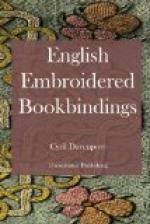(4) The preponderance of applique work, and raised work in metal guimps on embroidered books, especially on velvet, is easily accounted for when the principles they illustrate are understood, the truth being that in both these operations the maximum of surface effect is produced with the minimum of under work.
If the piece applique is not very large, a series of small stitches along all the edges is generally enough to keep it firm; such edge stitches are in most cases afterwards masked by a gold cord laid over them. If, however, the applique piece is large it will be necessary to fix it as well with some supplementary stitches through the central portions. These stitches will generally be so managed that they fit in with, or under, some of the ornamental work; at the same time, if necessary, they may be symmetrically arranged so as to become themselves of a decorative character.
The Embroidered Books here illustrated.
For the purposes of illustration I have chosen the most typical specimens possible from such collections as I have had access to. The chief collections in England are, undoubtedly, those at the British Museum and at the Bodleian Library at Oxford. The collection at the British Museum is especially rich, the earlier and finer specimens almost invariably having formed part of the old Royal Library of England given by George II. to the Museum in 1757.
The more recent specimens have been acquired either by purchase or donation, but as there has been no special intention at any time to collect these bindings, it is remarkable that such a number of them exist in our National Library. The Bodleian is rich in a few fine specimens only, and most of these are exhibited. My illustrations are made from photographs from the books themselves in all instances; to show them properly, however, all should be in colour, and it should not be forgotten that an embroidered book represented only by a half-tint print, however good, inevitably loses its greatest charm. However, if the half-tint is unworthy, the colour prints are distinctly flattering. I think that almost any old book well reproduced in colour gains in appearance, and in two of my colour plates I have actually restored some parts. In the beautiful fourteenth century psalter, supposed to have been worked by Anne de Felbrigge, I have made the colours purposely much clearer than they are at present. If it were possible to clean this volume, the colours would show very nearly as they do on my plate; but, actually, they are all much darker and more indistinct, being in fact overlaid with the accumulated dirt of centuries. The other instance where I have added more than at present exists on the original is the green velvet book which belonged to Queen Elizabeth, and forms my frontispiece. Here I have put in the missing pearls, each of which has left its little impression on the velvet, so nothing is added for which there is not the fullest authority. Moreover, some of the gold cord is gone on each of the three volumes of this work, but I have put it in its proper place for the purpose of illustration. The other plates are not in any way materially altered, but it may be allowed that the colour plates show their originals at their best.




